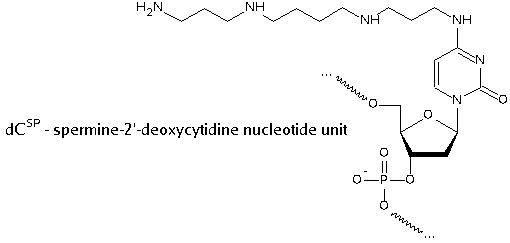| Search for content and authors |
Synthesis of a Polyaminooligonucleotide Combinatorial Library and Studies of Properties of Polyaminooligonucleotides |
| Przemysław Godzina , Anna Orłowska , Maria Markiewicz 1, Wojciech T. Markiewicz 1 |
|
1. Instytut Chemii Bioorganicznej PAN (ICHB-PAN), Noskowskiego 12/14, Poznań 61-704, Poland |
| Abstract |
Automatic synthesis of polyaminooligonucleotides (PAOs) utilizing fully protected polyamino-2'-deoxynucleoside 3’-phosphoramidites was carried out. PAO structures were analyzed by FAB-MS and MALDI-TOF. A polyaminooligonucleotide combinatorial library (SPAOCL) containing spermine-2’-deoxycytidine units (dCSp) attached to polystyrene support was synthesized. Analysis of hybridization properties of PAOs in SPAOCL with fluorescently labeled complementary probe revealed the stabilizing effect of spermine modification of cytosine residue upon duplex formation. Moreover, hybridization experiments using SPAOCL revealed influence of PAOs overall charge upon their hybridization properties. The question of unspecific hybridization was addressed and PAOs were shown to be a new example of cationic oligonucleotides.
In order to study in more detail the stabilizing effect of dCSp established by analysis of the combinatorial library SPAOCL all 16 members of that library were synthesized. Then, their ability to form complementary duplexes was studied by measuring melting temperatures (Tm) The collected data corroborate high stabilizing effect of one spermine modification in a chain (increase of Tm by ca 8 °C). More strikingly, two spermine residues in a chain still stabilize the duplex with a complementary d-AAAAGGGG in comparison with unmodified duplex. The latter case is quite interesting not only that the close neighborhood of two modifications still allows for a stabilizing effect but also because this oligonucleotide carries a much smaller overall electric charge (-1 in contrary to -7 of unmodified d-CCCCTTTT). Literature |
| Legal notice |
|
Presentation: Poster at VI Multidyscyplinarna Konferencja Nauki o Leku, by Wojciech T. MarkiewiczSee On-line Journal of VI Multidyscyplinarna Konferencja Nauki o Leku Submitted: 2008-02-29 14:33 Revised: 2009-06-07 00:48 |